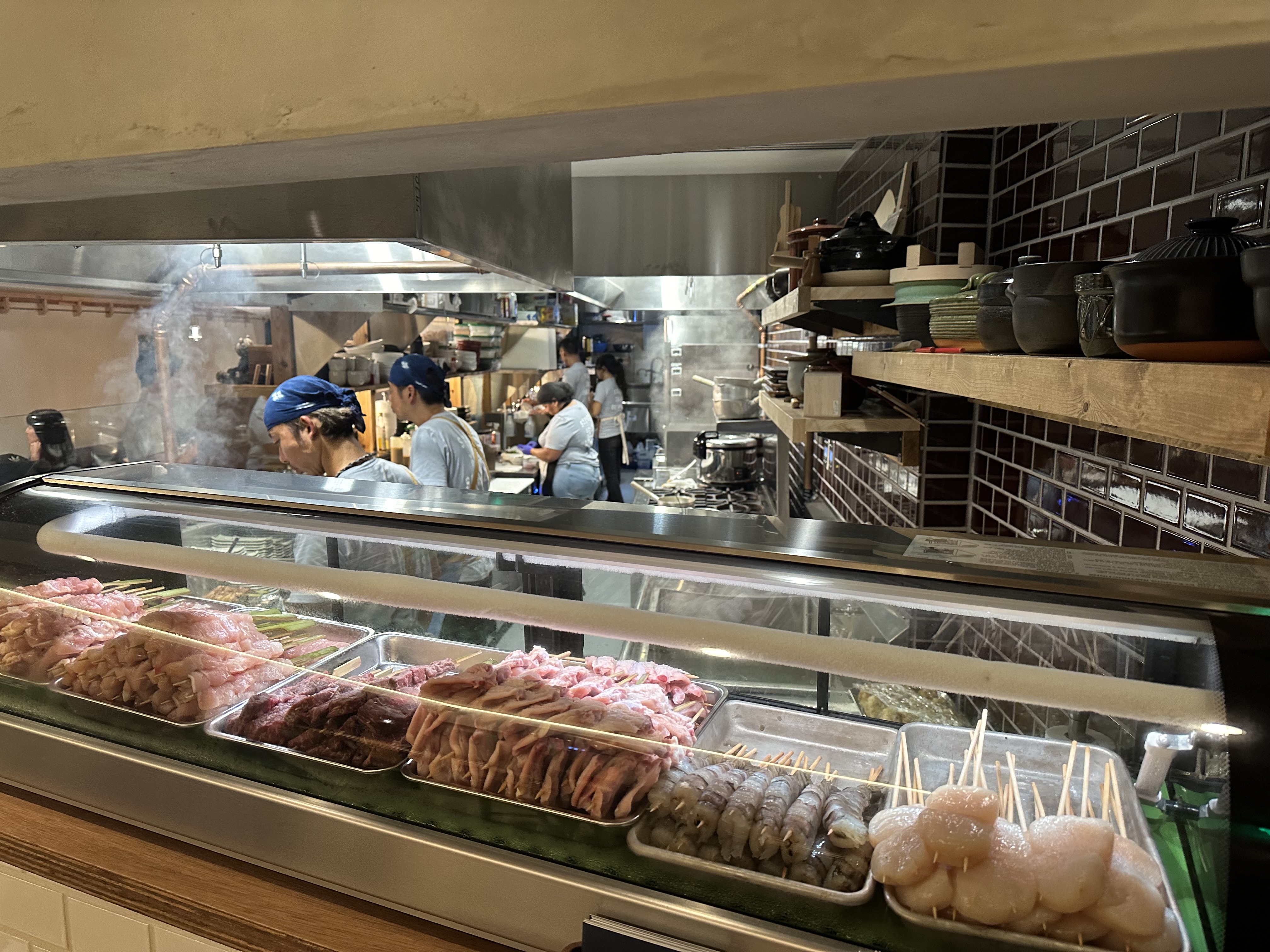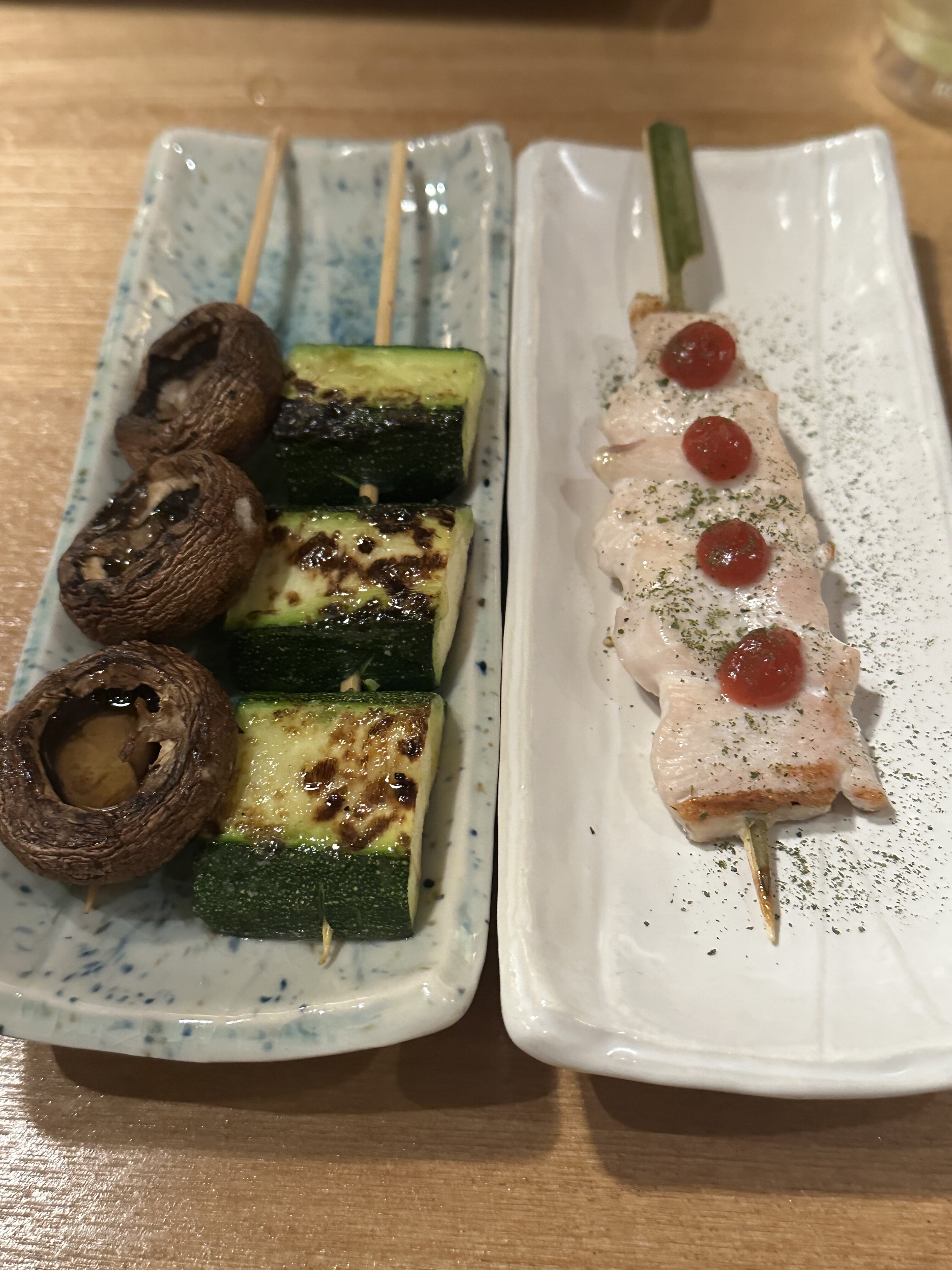by Richard Foss
“This is a great cuisine for someone with a short attention span,” I remarked to my dining companion on my first visit to Zoku. At the time, I was eyeing a selection of skewered seafood, meats, and vegetables that was arriving at the next table. Each sliver of bamboo had one or two bites of food, enough to get a brief taste before discarding the empty skewer and moving on to the next experience. Like Chinese dim sum or Spanish tapas, there is a parade of flavors and textures that lasts throughout the meal.
They serve more than just barbecued items at the new yakitori restaurant in Riviera Village, and you can have an interesting meal without including anything that has spent time over the fire. But skewers are the heart of the menu. The restaurant’s name reflects their particular specialty – Zoku is a contraction of the Japanese phrase Torikizoku, which means “bird aristocracy.” This is the first US outpost of a chicken-focused chain with over 600 outlets in Japan, though this operation is a bit different from the original. Those offer a rustic tavern feel with minimalist decor, while the Redondo operation has a cheerful display of culinary bric-a-brac interspersed with random items like an antique telephone, jars of beans, and a vintage camera.

The menu offers about 20 starters and salads and 15 skewered items. Since portions are small, you can order a few of each to share and have a highly varied meal. There are some traditional items like the cucumber salad and grilled rice ball, but most have modern elements. An example is the karaage fried chicken topped with bamboo charcoal sauce, a description I found so puzzling that I had to ask our server. They explained that the chef does indeed burn bamboo and then adds the ashes to a sauce in which I could taste sesame oil, sansho chili, and a bit of miso. I couldn’t have identified the smoky undertone to the sauce myself, because I had never had anything like this before. I suggested to our server that the sauce might also be offered with fried tofu for those who don’t eat chicken, because it would be good on almost any protein. As for that chicken, it was cooked to Japanese rather than American standards, and Japanese think Americans overcook chicken. It’s cooked just to doneness, and is extremely juicy with a very smooth texture, and most American fried chicken is dry and fibrous in comparison.
Another innovation is the “cream cheese tofu,” with baguette and maple syrup. This is actually housemade cream cheese sculpted to look like a standard tofu, served over the syrup with toasted bread. The cheese is very rich and fresh, but this seems more like a breakfast item than a starter at dinner. I noticed the Japanese-speakers at the adjacent table digging into it with gusto, so evidently this is different across cultures.
I prefer tofu to cream cheese, so ordered the tofu salad on one visit. The tofu was fried very crisp but was an incidental part of a very large portion of greens in a bland dressing. It was okay, but not something I’d order again when so many more interesting things are offered.
The other starter we tried was giant ebi mayo, huge prawns that had been tempura battered and fried, then tossed in a mix of mayonnaise and chili sauce. All I can say about it is that if you like shrimp and tolerate moderately spicy food, order it. They arrive still crisp despite the sauce coating, and the mayo takes the edge of the chili heat.
We also tried a daily special of cold fried conger eel with pickled onions, steamed baby pattypan squash, and cilantro over a yuzu sauce. Conger eel, called anago, lives in salt water and is different from the unagi freshwater eels that are a sushi bar staple. Freshwater eel is fatty and is usually eaten with sauce, while saltwater eel is more delicate and has a denser texture. This was an unusual setting for anago, and the vegetables and hint of citrus complemented the flavors nicely. It may not be offered for long as it’s a seasonal item, but if it is, it’s recommended.
Over the course of the two visits, I tried one shochu and yuzu cocktail and four types of sake, three cold and one hot. Yuzu citrus has a flavor reminiscent of an orange crossed with a lime, and along with shochu and soda water it’s a fine summer cooler. The sakes were more interesting, and more suited to a fall evening. Most restaurants use cheap and sugary sake for heated drinks, but this was made with Toji-kan, one of the better brands that claims to be the most popular sake in Japan. It’s on the sweet side, but it’s a balanced sweetness with a little nuttiness and depth. The cold sakes were Hanaharu, Immortal Wing, and my favorite, the “Sensation White” by Emishiki. All three were very good, but Sensation stood out as a complex sake that is worthy of sipping slowly and savoring.

The skewers we tried were the chicken breast with shiso leaf and dots of plum sauce, chicken meatball, Hokkaido scallop, baby bella mushroom, zucchini, and potatoes, with a rice ball on the side. The chicken skewer was lightly done so the meat was still a bit pink and had little caramelization — you taste the smoke from the Japanese bincho charcoal, but that’s not all you taste. The shiso, a Japanese member of the mint family, had been finely ground and sprinkled on after cooking, with the plum sauce added afterward. Get this and the chicken meatball side by side to appreciate both different flavors and textures — the meat skewer is made with white breast meat, while the meatball is dark thigh. The meatball is enhanced with a sauce called tare that also has a mix of herbal elements and sweetness, in this case thanks to the base of soy, ginger, sugar, and ginger. I prefer the richness and flavor of the dark meat, but your tastes may differ.
The giant scallop skewer is another must have, the big, meaty cold-water shellfish brushed with soy butter and otherwise just tasting of seafood and a hint of smoke. Hokkaido scallops are often seared to get a tasty caramelized crust, and here they’re cooked so they get just a bit of one but retain their flavor and almost gelatinous interior.
The zucchini and mushroom skewers are good but not exceptional, nice side flavors to alternate with proteins, with the colorful potatoes a bit more interesting. Baby potatoes are cooked and cooled and then finished just before serving, the same technique that Belgians use on french fries. In both cases the moisture is sealed inside, and the butter and soy glaze helps to add both texture and flavor.
Besides the veggies, we also had rice balls as an accompaniment. The ball of steamed rice mixed with seaweed and bonita flakes had been grilled so that it got just a bit of tasty, crispy char on the outside. It was a classic well executed.
Three desserts are offered. We tried the matcha crème brulee and a roasted panna cotta infused with salted caramel syrup. I had feared that the panna cotta would be overly sweet, but it wasn’t. It was a curious mix of flavors that grew on me as I ate it, not something I have to have again. I was happier with the matcha chocolate panna cotta, which had a little sweetness and saltiness contrasting with the bitterness of green tea and chocolate. It wasn’t quite like any dessert I can remember having, and I’d order it again – that is, if they’re out of their chocolate mont blanc, as they were on our most recent visit. One was served at the neighboring table, and it was a beautiful tower of food that they ate with rapturous exclamations in Japanese.
Dinner at Zoku is modestly priced for the quality and the excellent service – there is a large staff, and our servers Miruya and Kai were very helpful. Dinner for two with three drinks ran a hair over $100, a bargain for an excursion into modern takes on an ancient cuisine. Prepare yourself for an adventure and go – it’s an experience like nothing else in the beach cities.
Zoku is at 261 Avenida del Norte in Redondo Beach. Open Wed.-Sun. 4 to 9 p.m. Sun. 4 to 8:30 p.m. Street parking or adjacent lot. Beer and wine, some vegetarian items. Noise level medium. (650) 376-5476. Zokuyakitori.com. ER








